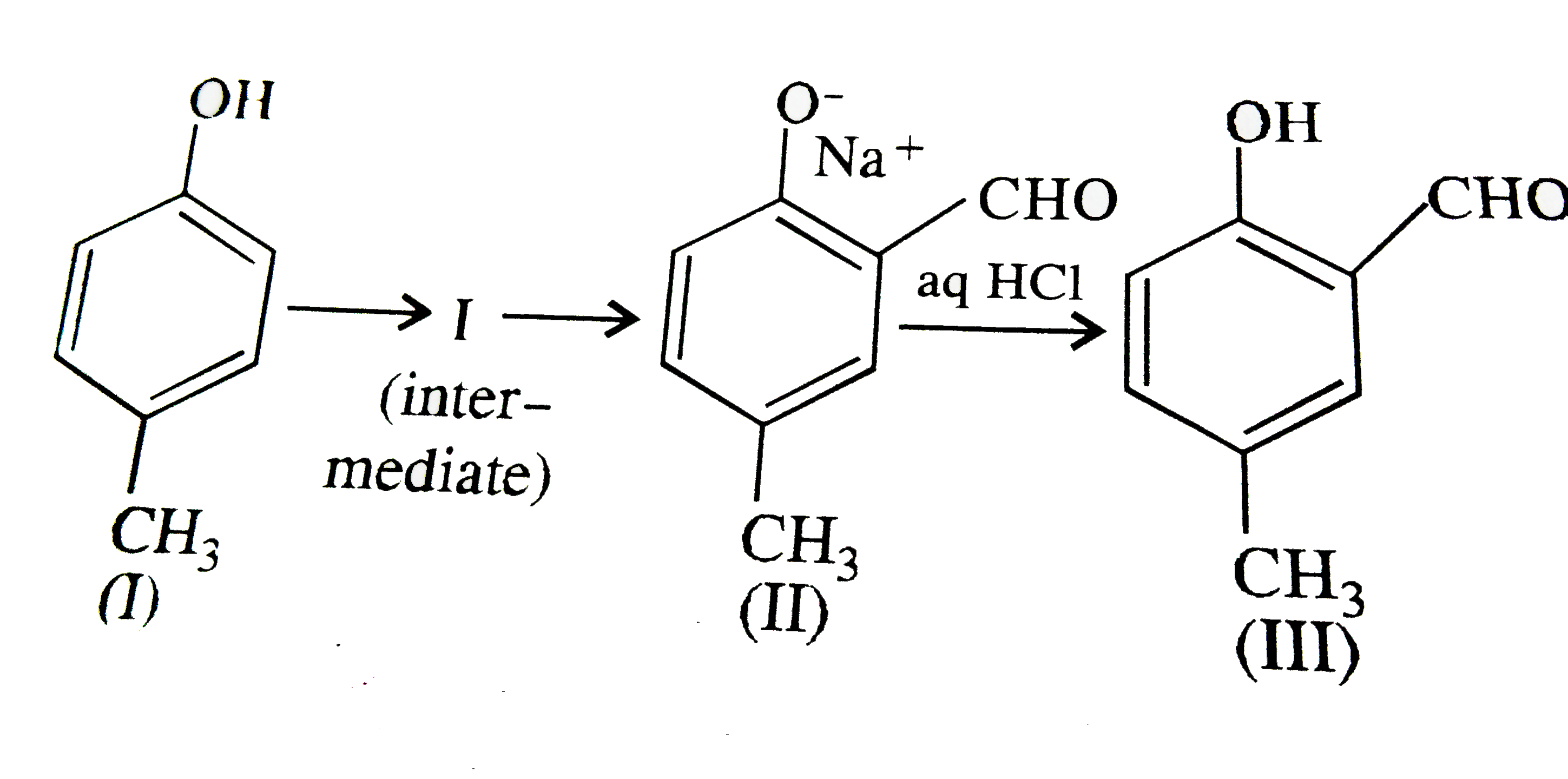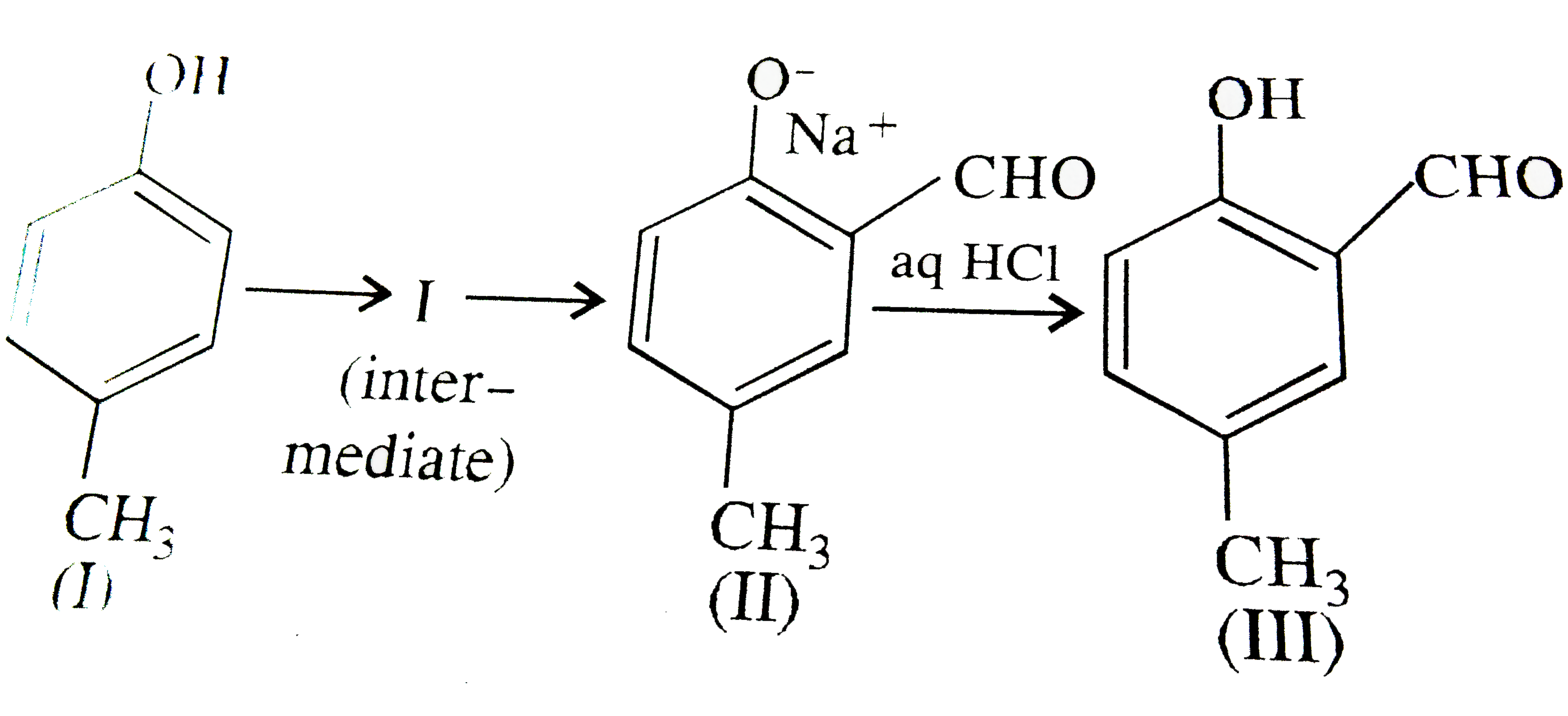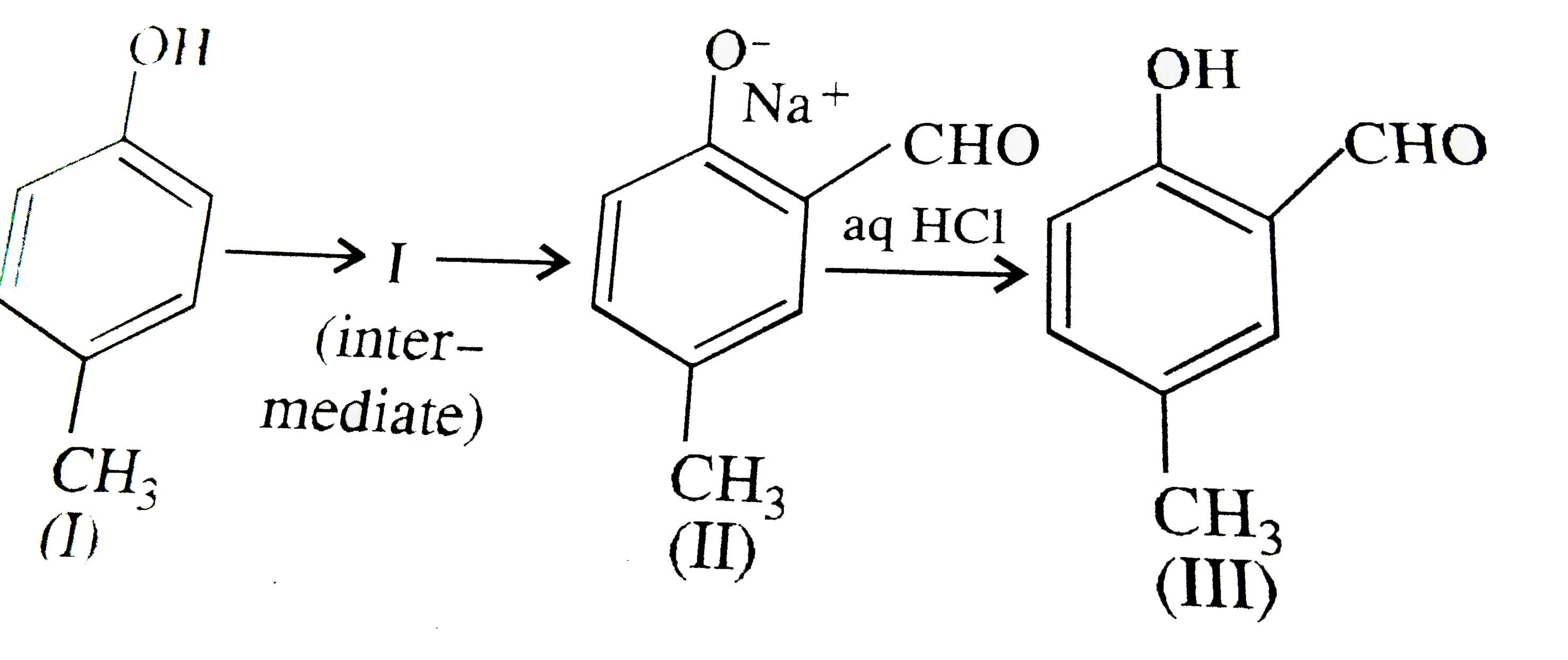Complete Solutions to Linked Comprehension Type MCQs of chapter ALCOHOLS AND PHENOLS of Class 11 book with complete answers and questions
| Class 11 | CHEMISTRY |
| Chapter | ALCOHOLS AND PHENOLS |
| DINESH OBJECTIVE CHEMISTRY | Linked Comprehension Type MCQs |
| Number Of Questions | 8 |
| Academic Year | 2023-24 |
Reimer Tiemann reaction introduces an aldehyde group, on to the ring of phenol, ortho to hydroxyl group. The reaction involves electro-philic aromatic substitution. This is a general method for synthesis of substituted salicyladehyde as depicted below

Which one of the following reagents is used in the above reactions
View SolutionReimer Tiemann reaction introduces an aldehyde group, on to the ring of phenol, ortho to hydroxyl group. The reaction involves electro-philic aromatic substitution. This is a general method for synthesis of substituted salicyladehyde as depicted below

The electrophile in this reaction is
View SolutionReimer Tiemann reaction introduces an aldehyde group, on to the ring of phenol, ortho to hydroxyl group. The reaction involves electro-philic aromatic substitution. This is a general method for synthesis of substituted salicyladehyde as depicted below

The structure of the intermediate is
View SolutionBoth alcohols and phenols contain a hydroxyl group, but phenols are more acidic than alcohols. The reason being that the phenoxide ion left after the removal of a proton is resonance stabilized while alkoxide is not. Therefore, phenols dissolve in aqueous sodium hydroxide but alcohols do not. However, both are weaker acids than carbonic acid and hence do not decompose aqueous `NaHCO_(3)` solution evolving `CO_(2)`. The presence of electron-donating groups in the benzene ring decrease the acid strength while the presence of electron withdrawing groups in the benzene ring increase the acid strength of phenols. The relative strength of o-, m- and p- substituted phenols, however, depends upon a combination of inductive and resonance effects of the substituent.
Alcohols are very weak acids even weaker than water. Because of the `+I` effect of the alkyl groups, tha acidic strength of alcohols decreases in the order : `1^(@)` alcohol `gt 2^(@)` alcohol `gt 3^(@)` alcohol.
The correct order of reactivity of `1^(@), 2^(@)` and `3^(2)` alcohols towards sodium metal is
View SolutionBoth alcohols and phenols contain a hydroxyl group, but phenols are more acidic than alcohols. The reason being that the phenoxide ion left after the removal of a proton is resonance stabilized while alkoxide is not. Therefore, phenols dissolve in aqueous sodium hydroxide but alcohols do not. However, both are weaker acids than carbonic acid and hence do not decompose aqueous `NaHCO_(3)` solution evolving `CO_(2)`. The presence of electron-donating groups in the benzene ring decrease the acid strength while the presence of electron withdrawing groups in the benzene ring increase the acid strength of phenols. The relative strength of o-, m- and p- substituted phenols, however, depends upon a combination of inductive and resonance effects of the substituent.
Alcohols are very weak acids even weaker than water. Because of the `+I` effect of the alkyl groups, tha acidic strength of alcohols decreases in the order : `1^(@)` alcohol `gt 2^(@)` alcohol `gt 3^(@)` alcohol.
Which of the following is the strongest acid
View SolutionBoth alcohols and phenols contain a hydroxyl group, but phenols are more acidic than alcohols. The reason being that the phenoxide ion left after the removal of a proton is resonance stabilized while alkoxide is not. Therefore, phenols dissolve in aqueous sodium hydroxide but alcohols do not. However, both are weaker acids than carbonic acid and hence do not decompose aqueous `NaHCO_(3)` solution evolving `CO_(2)`. The presence of electron-donating groups in the benzene ring decrease the acid strength while the presence of electron withdrawing groups in the benzene ring increase the acid strength of phenols. The relative strength of o-, m- and p- substituted phenols, however, depends upon a combination of inductive and resonance effects of the substituent.
Alcohols are very weak acids even weaker than water. Because of the `+I` effect of the alkyl groups, tha acidic strength of alcohols decreases in the order : `1^(@)` alcohol `gt 2^(@)` alcohol `gt 3^(@)` alcohol.
The acidic strength decreases in the order
View SolutionBoth alcohols and phenols contain a hydroxyl group, but phenols are more acidic than alcohols. The reason being that the phenoxide ion left after the removal of a proton is resonance stabilized while alkoxide is not. Therefore, phenols dissolve in aqueous sodium hydroxide but alcohols do not. However, both are weaker acids than carbonic acid and hence do not decompose aqueous `NaHCO_(3)` solution evolving `CO_(2)`. The presence of electron-donating groups in the benzene ring decrease the acid strength while the presence of electron withdrawing groups in the benzene ring increase the acid strength of phenols. The relative strength of o-, m- and p- substituted phenols, however, depends upon a combination of inductive and resonance effects of the substituent.
Alcohols are very weak acids even weaker than water. Because of the `+I` effect of the alkyl groups, tha acidic strength of alcohols decreases in the order : `1^(@)` alcohol `gt 2^(@)` alcohol `gt 3^(@)` alcohol.
Which of the following is the strongest acid
View SolutionBoth alcohols and phenols contain a hydroxyl group, but phenols are more acidic than alcohols. The reason being that the phenoxide ion left after the removal of a proton is resonance stabilized while alkoxide is not. Therefore, phenols dissolve in aqueous sodium hydroxide but alcohols do not. However, both are weaker acids than carbonic acid and hence do not decompose aqueous `NaHCO_(3)` solution evolving `CO_(2)`. The presence of electron-donating groups in the benzene ring decrease the acid strength while the presence of electron withdrawing groups in the benzene ring increase the acid strength of phenols. The relative strength of o-, m- and p- substituted phenols, however, depends upon a combination of inductive and resonance effects of the substituent.
Alcohols are very weak acids even weaker than water. Because of the `+I` effect of the alkyl groups, tha acidic strength of alcohols decreases in the order : `1^(@)` alcohol `gt 2^(@)` alcohol `gt 3^(@)` alcohol.
The strongest acid among the following is
View Solution
Linked Comprehension Type MCQs questions and complete solutions for chapter ALCOHOLS AND PHENOLS of S DINESH & CO CHEMISTRY (HINGLISH) of Class 11